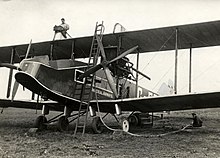Handley Page W.8
| Handley Page W.8 | |
|---|---|
 Handley Page W.8 prototype |
|
| Type: | Airliner |
| Design country: | |
| Manufacturer: | |
| First flight: |
December 2, 1919 |
| Commissioning: |
1921 |
| Number of pieces: |
25th |

The Handley Page W.8 and the derived models W.9 and W.10 were two to three-engine, double-decker airliners made by the British manufacturer Handley Page from the time after the First World War . The aircraft was based on the Handley Page W / 400 and was the world's first aircraft with a toilet on board.
history
After the O / 400 proved unsuitable for civil use, Handley Page began designing his first aircraft designed exclusively for non-military use. The original design Handley Page W / 400 (referred to as HP16 from 1924) provided for sixteen passenger seats. The two pilots sat in an open cockpit. The wings and the undercarriage came from the V / 1500 in a slightly different form . Two Rolls-Royce Eagle VIII engines served as drive . The first flight took place on August 22, 1919.
During the test flights, the engines proved to be too weak. So Handley Page decided to build an improved prototype. This was named W.8, from 1924 HP18. The new aircraft differed from its predecessor in that it had two Napier Lion IB engines, a smaller wingspan and a new tail. The number of passenger seats fell to fifteen.
The W.8 completed its maiden flight on December 2, 1919. Since the Lion engine proved to be problematic, Eagle VIII engines were again installed in the production version W.8b (HP26). The aircraft were therefore only approved for twelve passengers. From 1923 the more powerful Eagle IX drive was available, and the aircraft equipped with it were given the designation W.8c.
Three-engine variants were the W.8e and W.8f with an Eagle-IX and two Siddeley-Puma engines. In the following years the versions W.9 (HP27) emerged with three Siddeley Jaguar - radial engines and W.10 (HP30) with two Lion IIB motors. The Handley Page Hyderabad bomber was built on the basis of the W.8 .
With the commissioning of the Handley Page HP42 in 1931, Imperial Airways ended the use of the W series. While some machines came into private ownership, the two remaining W.10s were converted into tanker aircraft.
Versions
W.8
The W.8 served as a prototype and was equipped with two Napier Lion engines. It was the world's first aircraft with a toilet on board.
W.8b
Due to the regulations of the Air Ministry , the capacity was reduced to twelve passengers and the fuel tanks relocated. The drive consisted of two Rolls-Royce Eagle -VIII engines.
In 1921 the Department of Aviation ordered three models which were given to the airline Handley Page Transport . After the takeover by Imperial Airways , they operated the routes from London to Paris and Brussels . In 1924, SABENA acquired an aircraft, and three more aircraft were built under license from SABCA in Belgium .
W.8c
The W.8c was built in 1923 and was powered by two Rolls-Royce Eagle IX engines.
W.8e
To reduce the risk of drive failure, the W.8e received three engines. A Rolls-Royce Eagle IX engine was located in the bow, and two Siddeley Puma were installed between the wings . Of the aircraft ordered by SABENA, one was built by Handley Page, the other eight were licensed by the Belgian manufacturer SABCA.
W.8f and W.8g Hamilton
The W.8f took over the drive of the W.8e and had a cabin heater and a revised tail unit. Imperial Airways acquired one aircraft and two aircraft built under license from SABCA went to SABENA.
In 1929 the Imperial Airways aircraft was converted to the W.8g. It received the tail unit of the W.10, the nose engine was removed, and the two remaining drives were replaced by two Rolls-Royce Eagle XIIA engines.
W.9a Hampstead
The W.9a had three Armstrong Siddeley Jaguar IV radial engines . The aircraft set a new record for Imperial Airways when it took only 86 minutes to travel from London to Paris. In 1926 the engine was changed to three Bristol-Jupiter VI drives. This was linked to the admission for fourteen passengers. The aircraft was then moved to Australia , where it was destroyed in an accident nine months later.
W.10
The W.10 had two Napier Lion IIB engines. All four copies built in 1926 came into the possession of Imperial Airways and some remained in service until 1933.
Technical data (W.8f)
| Parameter | Data |
|---|---|
| crew | 2 |
| Passengers | 12 |
| length | 18.33 m |
| span | 22.92 m |
| height | 5.18 m |
| Wing area | 135.3 m² |
| Empty mass | 3910 kg |
| Takeoff mass | 5910 kg |
| Cruising speed | 137 km / h |
| Top speed | 166 km / h |
| Service ceiling | 3960 m |
| Engines | a Rolls-Royce Eagle IX with 360 PS / 269 kW, two Siddeley Puma with 244 PS / 179 kW each |
See also
literature
- CH Barnes: Handley Page Aircraft Since 1907. Putnam & Company Ltd., London 1987, ISBN 0-85177-803-8 .
- Donald C. Clayton: Handley Page. An Aircraft Album. Ian Allan Ltd., Shepperton 1969, ISBN 0-7110-0094-8 .
- AJ Jackson: British Civil Aircraft since 1919. Volume 2. (2nd Edition) Putnam & Company Ltd., London 1973, ISBN 0-370-10010-7 .
Web links
Individual evidence
- ↑ Handley Page Three-Engined Commercial Airplane For Belgium. (PDF) In: Flight, May 1, 1924. Flight, May 1, 1924, pp. 248–253 , accessed on December 2, 2019 (English).

